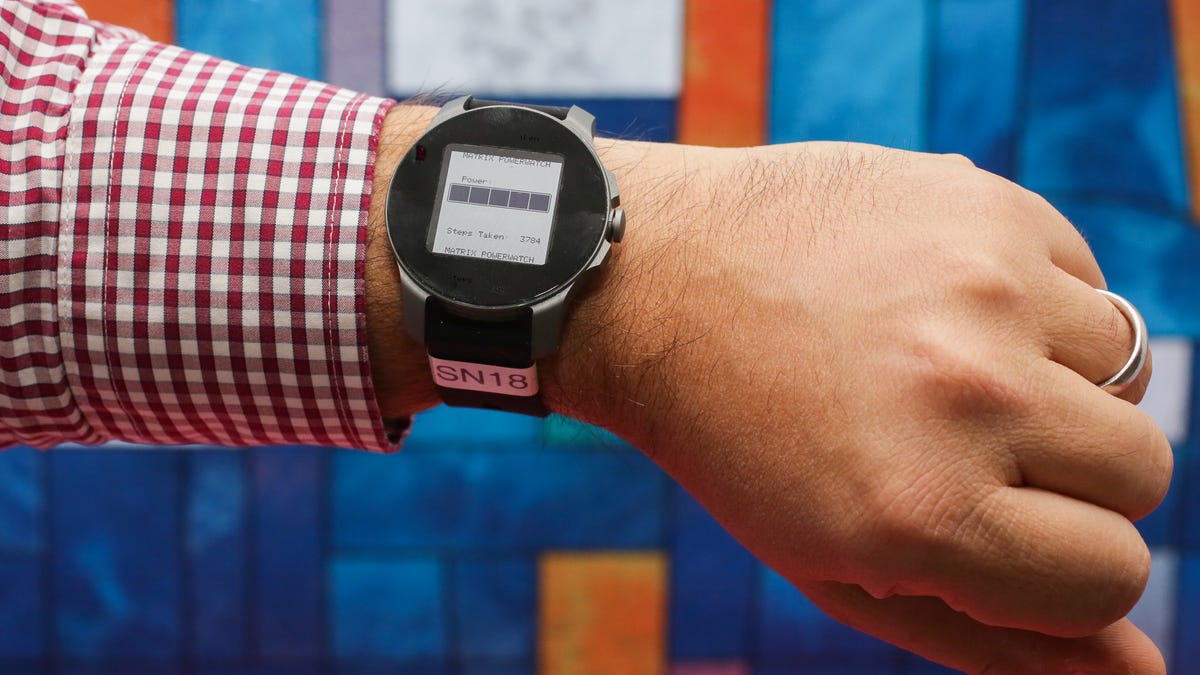The dream of the no-charge watch: Matrix PowerWatch claims to run on your body heat (hands-on)
How soon before wearables can skip charging completely? The Matrix watch aims for next year.

Smartwatches and fitness trackers -- heck, all consumer electronics -- have one major downside: battery life. They need to be charged.
What if they didn't, though?
Conquering the challenges of batteries and the limits of power-efficient processing are things the electronics industry as a whole continues to struggle with. One company thinks it has found a small solution that could spread to much greater things.
What the Matrix PowerWatch will look like in its final form (which I didn't get to see).
The Matrix PowerWatch, now available to preorder via Indiegogo, claims to be a fitness-tracking watch that uses your own body heat to stay perpetually charged. Yes, like in "The Matrix."
How exactly does this work? The Matrix watch uses temperature gradients to create electrical current, and then uses a transformer to amplify the charge to run a low-power processor.
Trying on a prototype of the Matrix PowerWatch at the office. The display shows a charging bar that fills as I wear it.
The watch's design depends on side ridges that act as heat vents, wicking heat away so the temperature gradient can remain. The final watch design will look more streamlined, according to photos. I hope so, because the version I tried was pretty bulky and experimental-looking. The photo of the finalized watch coming in 2017 looks far more streamlined, with an interface that will include watch faces and exercise timers.
The PowerWatch will track steps, calories burned, activity and sleep, and has 50-meter water resistance for swimming. The watch will sync with iOS and Android.
I tried a brief demo in CNET's office of a Matrix watch prototype with Douglas Tham, co-founder and CTO of Matrix Industries. In my brief time with the watch, I couldn't tell if it would stay charged long-term. But I saw the watch would charge its little energy bar when it was on my wrist, and the display showed the time and how many steps I'd taken.
One benefit to using thermoelectrics in the Matrix PowerWatch could be calorie reading: Tham says that the ability to measure thermal energy expended will make the watch the best wrist-worn calorimeter on the market.
The ridges on the side are there to help dissipate heat and keep a larger temperature gradient.
The display on the test watch I tried had really small text, and it didn't always register my body heat to charge -- something that may have had to do with the temperature of the room I was in, or maybe because it was an early prototype. Once I started running in place a bit, it seemed to work better.
The watch goes into low-power sleep mode when not being worn. According to Tham, once it's charged it could last in high-power mode for two years, and in a sleep state "for decades." Of course it sounds too good to be true, but the Matrix watch's Indiegogo campaign is live and kicking, and Matrix intends the watch to ship next summer for $160.
What the final version of the watch should look like.
According to Tham, the Matrix technology works off any temperature gradient: cold to hot, hot to cold. On my wrist, it's the heat of my skin compared with the room temperature. Tham told me Matrix's tech is also being applied to industrial applications like powering internet-of-things sensors in rooms, and there's research into possible uses in medical implants.
The Matrix watch is the first piece of consumer technology attempting to use this power-generating concept. It's still really low-power: It can't track heart rate, just steps and time. The watch can't generate enough energy to run a more advanced smartwatch like an Apple Watch.
Strangely, the watch doesn't use kinetic energy or solar power, two technologies that already exist to help keep traditional watches running without charging. Tham says these are also being explored, and that temperature gradients combined with other technology like solar charging and kinetic energy storage could maybe go further in the future.
I can't judge something like the PowerWatch from a brief demo. But if it works and a fitness-tracking watch can be powered off body heat, it could mean something for low-powered basic fitness trackers down the road.
I'll reserve further judgment until I get one to fully review, but it sounds like a dream.
As always, please note that CNET's reporting on crowdfunding campaigns is not an endorsement of the project or its creators. Contributing to a crowdfunded project comes with risk. Before contributing to any campaign, read the crowdfunding site's policies, such as those for Kickstarter and Indiegogo, to find out your rights (and refund policies, or the lack thereof) before and after a campaign ends.

